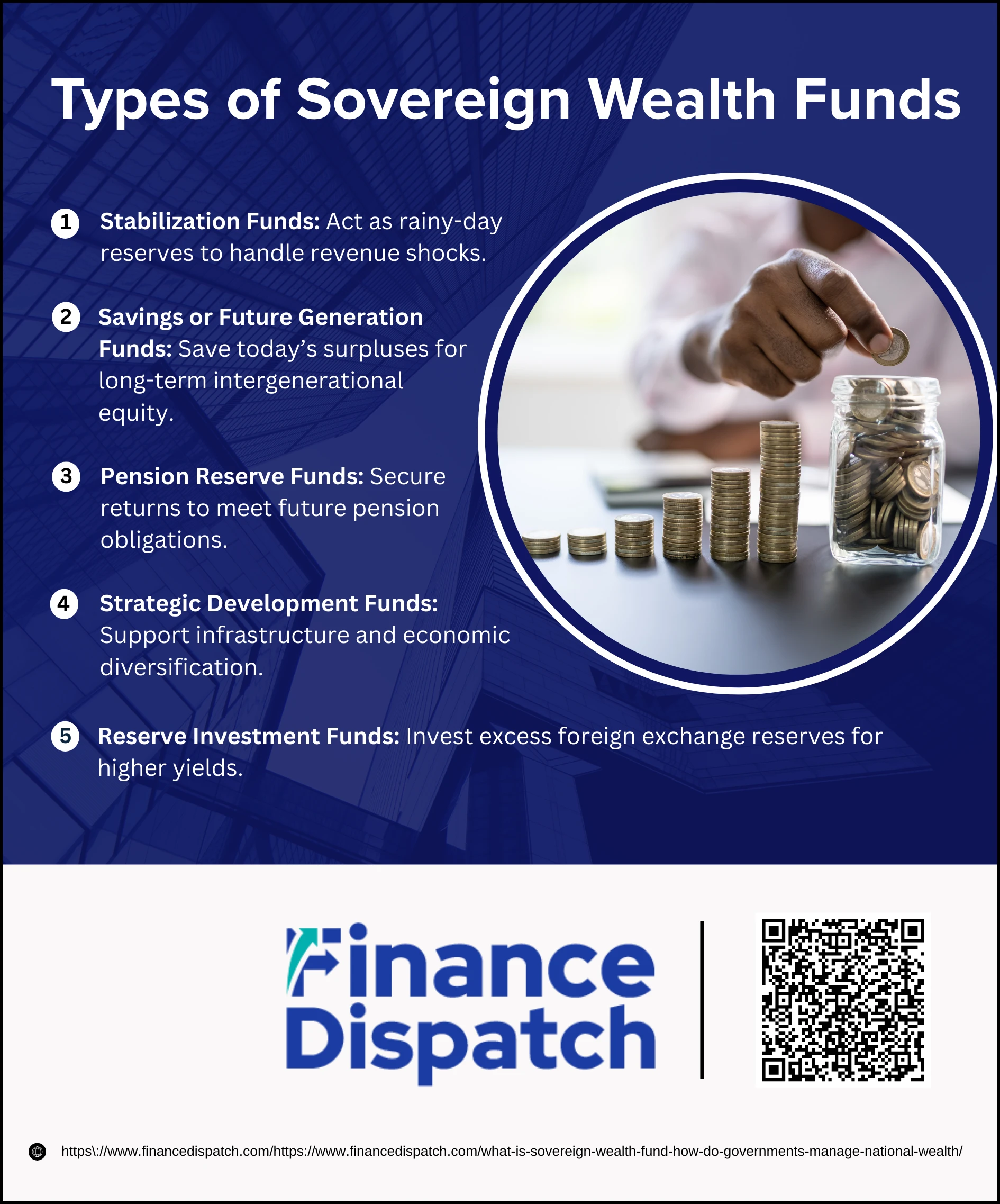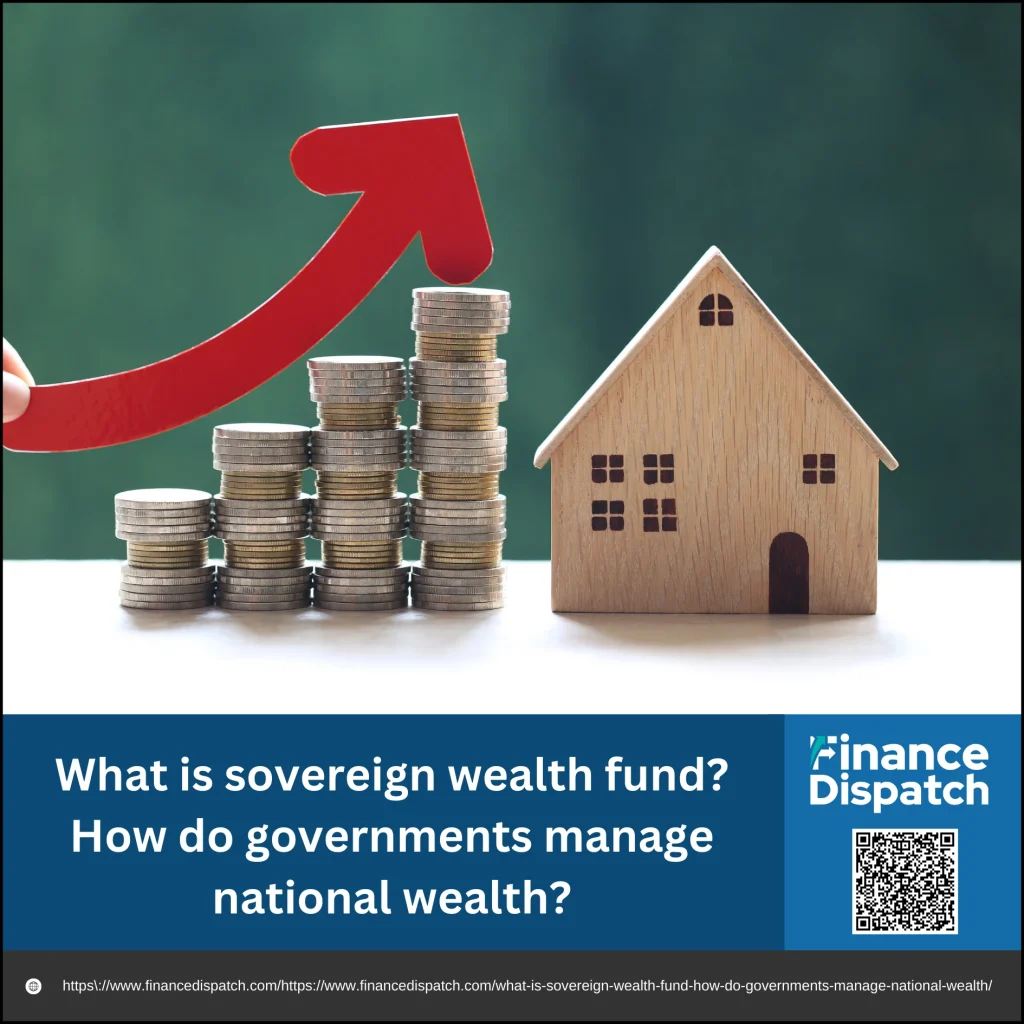Sovereign wealth funds (SWFs) have become one of the most powerful tools governments use to safeguard and grow national wealth. At their core, these funds are state-owned pools of money, often drawn from budget surpluses, natural resource revenues, or foreign exchange reserves, that are invested in a wide range of assets—from stocks and bonds to infrastructure and real estate. Unlike short-term fiscal measures, sovereign wealth funds are designed with a long-term vision: to stabilize economies during downturns, preserve wealth for future generations, and strategically strengthen a nation’s financial position. As more countries establish and expand these funds, understanding how they work and how governments manage them is key to grasping their growing influence on both domestic economies and global markets.
What is a Sovereign Wealth Fund?
A sovereign wealth fund (SWF) is essentially a nation’s savings and investment account, but on a much larger scale. It is a state-owned pool of money that governments set aside—often from budget surpluses, natural resource revenues like oil and gas, or foreign exchange reserves—and then invest in financial assets such as stocks, bonds, real estate, or infrastructure projects. Unlike central bank reserves, which are mainly used for monetary policy, sovereign wealth funds are designed to generate returns over the long term and serve the collective interests of the nation. Their purpose is not only to stabilize the economy during downturns but also to preserve wealth so that future generations can benefit from today’s resources.
Historical Background of Sovereign Wealth Funds
The origins of sovereign wealth funds date back to the mid-20th century, when resource-rich nations sought ways to safeguard and invest their budget surpluses. The very first fund, the Kuwait Investment Authority, was established in 1953 to manage excess oil revenues and ensure long-term financial security. Shortly after, Kiribati created a fund in 1955 to hold its revenue reserves. For the next two decades, progress was gradual, until the emergence of major funds such as the Abu Dhabi Investment Authority (1976), Singapore’s Government Investment Corporation (1981), and Norway’s Government Pension Fund (1990)—each setting a precedent for how countries could transform surplus revenues into strategic, long-term investments. These early examples laid the foundation for the growth of sovereign wealth funds worldwide, which have since evolved into powerful global investors shaping markets and economies.
 Why Do Governments Create Sovereign Wealth Funds?
Why Do Governments Create Sovereign Wealth Funds?
Governments create sovereign wealth funds (SWFs) because these funds act as a safeguard for the economy today and a financial cushion for the future. Instead of letting surplus revenues sit idle, governments use SWFs to invest in assets that can generate long-term growth and stability. Below are the main reasons, explained in detail:
1. Economic Stabilization
Many countries, especially those dependent on commodities like oil or gas, face revenue fluctuations when global prices swing. SWFs allow governments to set aside money during high-revenue years and use it when prices drop, helping to maintain steady public spending and protect against economic shocks. For example, Russia’s stabilization fund was built to counter oil price volatility.
2. Wealth Preservation for Future Generations
Natural resources such as oil, gas, and minerals are finite—they will eventually run out. To ensure future generations benefit from today’s resource wealth, countries like Norway established savings-focused sovereign wealth funds. Norway’s Government Pension Fund Global invests surplus oil revenues internationally so the nation remains financially secure long after its oil reserves are depleted.
3. Diversification of Income
Relying too heavily on a single income source makes a nation vulnerable. SWFs provide a way to diversify national income streams by investing in global equities, bonds, real estate, infrastructure, and emerging industries. This spreads risk across sectors and geographies, ensuring the economy does not collapse if one sector suffers.
4. Strategic Development
Beyond saving, many governments use SWFs to invest in national development. These funds finance long-term projects like roads, airports, energy plants, or even technology and innovation hubs. For instance, India’s National Investment and Infrastructure Fund (NIIF) channels capital into infrastructure, while Saudi Arabia’s Public Investment Fund is heavily involved in Vision 2030 projects aimed at economic diversification.
5. Global Influence and Soft Power
SWFs also act as tools of international influence. By acquiring significant stakes in foreign companies, real estate, or infrastructure, governments strengthen their global presence and foster economic partnerships. The Abu Dhabi Investment Authority, for example, is one of the largest global investors in real estate, giving the UAE both financial returns and geopolitical leverage.
Sources of Funding for Sovereign Wealth Funds
Sovereign wealth funds (SWFs) are built from different streams of national revenue that would otherwise remain unused or underutilized. By channeling these funds into investments, governments turn surplus resources into long-term financial assets that can support economic stability and growth.
Main sources of funding for sovereign wealth funds include:
1. Commodity Revenues – Profits from oil, natural gas, and mineral exports are the most common sources, especially in resource-rich nations such as Saudi Arabia, Kuwait, and the United Arab Emirates.
2. Fiscal Surpluses – When government revenues exceed expenditures, the surplus can be directed into an SWF instead of being spent immediately.
3. Foreign Exchange Reserves – Some countries convert excess foreign currency holdings into investment funds to generate better returns, as seen in China’s sovereign wealth funds.
4. Privatization Proceeds – Governments sometimes sell state-owned assets or companies and use the proceeds to seed or expand an SWF.
5. Transfers from State-Owned Enterprises – Profits generated by national companies, especially in energy or natural resources, may be redirected into sovereign wealth funds.
6. Other Government Transfers – Funds can also be capitalized through special taxes, tariffs, or one-time windfalls such as settlement payments or foreign aid inflows.
 Types of Sovereign Wealth Funds
Types of Sovereign Wealth Funds
Sovereign wealth funds (SWFs) are not all created with the same purpose—each fund is shaped by a country’s priorities, resources, and long-term economic vision. While some are designed purely as savings accounts for future generations, others focus on stabilizing the economy during downturns or driving domestic development. Broadly, SWFs can be classified into several main types:
Major types of sovereign wealth funds include:
1. Stabilization Funds
These are often called “rainy-day funds.” They help governments manage revenue volatility—especially in countries reliant on commodities like oil or gas. By saving during boom years and spending during downturns, stabilization funds protect against budget shocks. Example: Russia’s stabilization fund.
2. Savings or Future Generation Funds
Set up to preserve wealth for the long term, these funds save a portion of today’s resource revenues for future citizens once natural resources are depleted. Example: Norway’s Government Pension Fund Global, which invests oil revenues for intergenerational equity.
3. Pension Reserve Funds
These funds are designed to meet future pension liabilities and ease pressure on government budgets as populations age. They ensure stable returns to support national pension systems. Example: Chile’s Pension Reserve Fund.
4. Strategic Development Funds
Unlike traditional savings or stabilization funds, these are used to finance infrastructure, diversify economies, and support industries that align with national development goals. Example: Saudi Arabia’s Public Investment Fund under Vision 2030.
5. Reserve Investment Funds
These funds are created specifically to invest excess foreign exchange reserves. Instead of keeping reserves idle, governments seek higher yields by investing them globally. Example: China Investment Corporation.
 How Do Sovereign Wealth Funds Invest?
How Do Sovereign Wealth Funds Invest?
Sovereign wealth funds (SWFs) hold enormous financial power, and the way they invest determines not only the returns they generate but also their impact on economies worldwide. By spreading their capital across multiple asset classes, they balance risk with long-term growth. Here’s a closer look at their main investment strategies:
1. Equities (Stocks)
SWFs are some of the largest shareholders in global markets. By purchasing equity stakes in thousands of companies—from technology giants to consumer goods firms—they gain steady returns through dividends and capital appreciation. For instance, Norway’s Government Pension Fund Global owns shares in about 1.5% of all listed companies worldwide. The upside is long-term growth, though stock markets can be volatile in the short term.
2. Fixed Income (Bonds and Debt Securities)
Government bonds, treasury bills, and corporate debt instruments provide stable and predictable income. These investments are lower-risk compared to equities, making them a popular choice for funds seeking stability and liquidity. Bonds also act as a safeguard during market downturns, though their yields are typically lower.
3. Real Estate
Commercial properties, office buildings, retail spaces, and residential projects form another major investment avenue. Real estate provides both rental income and potential appreciation in value over time. Funds like the Abu Dhabi Investment Authority (ADIA) are well known for their vast global real estate portfolios, which add diversity and act as a hedge against inflation.
4. Infrastructure Projects
SWFs often finance large-scale infrastructure such as airports, toll roads, power plants, and ports. These investments support long-term national development goals while generating steady cash flows. India’s National Investment and Infrastructure Fund (NIIF), for example, focuses heavily on infrastructure to drive economic growth.
5. Private Equity and Venture Capital
Rather than only buying publicly traded stocks, some SWFs invest directly in private companies or startups with high growth potential. This provides exposure to innovation, emerging markets, and industries like technology, health care, and renewable energy. While riskier, private equity can deliver outsized returns compared to traditional investments.
6. Alternative Assets
Beyond traditional markets, SWFs diversify into hedge funds, commodities, renewable energy projects, and even farmland. These alternative investments help reduce reliance on stocks and bonds, balancing portfolios against global economic shifts. For example, several Gulf-based funds are investing heavily in renewable energy as part of their diversification strategies.
7. Domestic Industries
Some sovereign wealth funds reinvest directly into their home economies, supporting strategic sectors like manufacturing, energy, and technology. This strengthens domestic industries, creates jobs, and drives innovation. Saudi Arabia’s Public Investment Fund (PIF), for instance, plays a central role in Vision 2030, channeling investments into sectors that reduce the country’s reliance on oil.
Major Sovereign Wealth Funds Around the World
Sovereign wealth funds are now some of the largest and most influential investors on the planet, holding trillions of dollars in assets across different sectors and countries. While over 100 funds exist globally, only a handful dominate with massive portfolios that shape financial markets, fund infrastructure, and support long-term national strategies.
Leading sovereign wealth funds worldwide include:
| Country | Fund Name | Approx. Assets (USD) | Key Features / Focus Areas |
| Norway | Government Pension Fund Global | $1.7+ trillion | World’s largest SWF; invests in equities, bonds, real estate, renewable energy |
| China | China Investment Corporation | $1.3+ trillion | Manages foreign exchange reserves; invests in infrastructure & global markets |
| United Arab Emirates (Abu Dhabi) | Abu Dhabi Investment Authority (ADIA) | $1 trillion+ | Heavy investor in real estate, global equities, and infrastructure |
| Kuwait | Kuwait Investment Authority | $1 trillion | Oldest SWF (1953); built from oil revenues to secure long-term wealth |
| Saudi Arabia | Public Investment Fund (PIF) | $925 billion | Driving Vision 2030; invests in tech, renewable energy, and mega-projects |
| Singapore | GIC & Temasek Holdings | $800B+ (combined) | Focus on global investments, technology, healthcare, and domestic growth |
| Qatar | Qatar Investment Authority | $525 billion | Large stakes in banks, real estate, and luxury assets worldwide |
| Hong Kong | Monetary Authority Investment Portfolio | $510 billion | Diversified investments including equities, fixed income, and currency reserves |
Advantages and Disadvantages of Sovereign Wealth Funds
Sovereign wealth funds (SWFs) are powerful financial instruments that can bring significant benefits to national economies, but they are not without risks. Their success depends on how transparently and strategically they are managed. To understand their overall impact, it is important to weigh both their advantages and disadvantages.
Advantages of Sovereign Wealth Funds
- Help stabilize economies during downturns by providing financial reserves.
- Preserve resource wealth for future generations through long-term savings.
- Diversify national income streams beyond volatile sectors like oil or gas.
- Fund infrastructure projects and social programs that support development.
- Provide governments with steady investment returns to supplement revenues.
- Strengthen global influence by holding stakes in international companies and assets.
Disadvantages of Sovereign Wealth Funds
- Lack of transparency can lead to corruption, mismanagement, or public mistrust.
- Political interference may pressure funds into low-return or risky projects.
- Exposure to market volatility and currency fluctuations can erode value.
- Overconcentration in certain industries (e.g., energy or real estate) increases vulnerability to downturns.
- Ethical concerns may arise when funds profit from controversial industries or regimes.
- Public dissatisfaction may grow if returns are slow while domestic needs remain unmet.
Challenges in Managing Sovereign Wealth Funds
While sovereign wealth funds (SWFs) play a crucial role in stabilizing economies and preserving wealth, managing such massive pools of capital comes with complex challenges. Issues of transparency, governance, political influence, and global scrutiny often determine whether these funds succeed in delivering long-term benefits or fall short of their objectives.
Key challenges in managing sovereign wealth funds include:
1. Transparency and Accountability – Some SWFs disclose little about their holdings or strategies, raising concerns of mismanagement or corruption.
2. Political Interference – Governments may pressure funds to finance local projects or political priorities, which can undermine investment returns.
3. Geopolitical Risks – Large foreign investments by SWFs can spark national security concerns in host countries, leading to restrictions or political tensions.
4. Ethical Dilemmas – Investing in fossil fuels, authoritarian regimes, or controversial industries can create conflicts with global sustainability goals.
5. Market Volatility – Like any investor, SWFs face risks from currency fluctuations, interest rate changes, and global financial crises.
6. Overconcentration of Assets – Some funds rely heavily on specific sectors (e.g., oil or real estate), making them vulnerable to cyclical downturns.
7. Public Expectations – Citizens often expect immediate benefits, but SWFs are designed for long-term returns, creating tension between short-term needs and future planning.
Conclusion
In conclusion, sovereign wealth funds represent a vital tool for governments to manage excess national wealth, safeguard against economic shocks, and invest in future prosperity. By channeling surpluses from natural resources, fiscal revenues, or foreign reserves into diverse global assets, these funds provide stability, create opportunities for development, and preserve wealth for generations to come. However, their effectiveness depends heavily on transparency, governance, and disciplined long-term management. When used wisely, sovereign wealth funds can serve as powerful engines of national resilience and growth, turning today’s resources into tomorrow’s security and progress.



